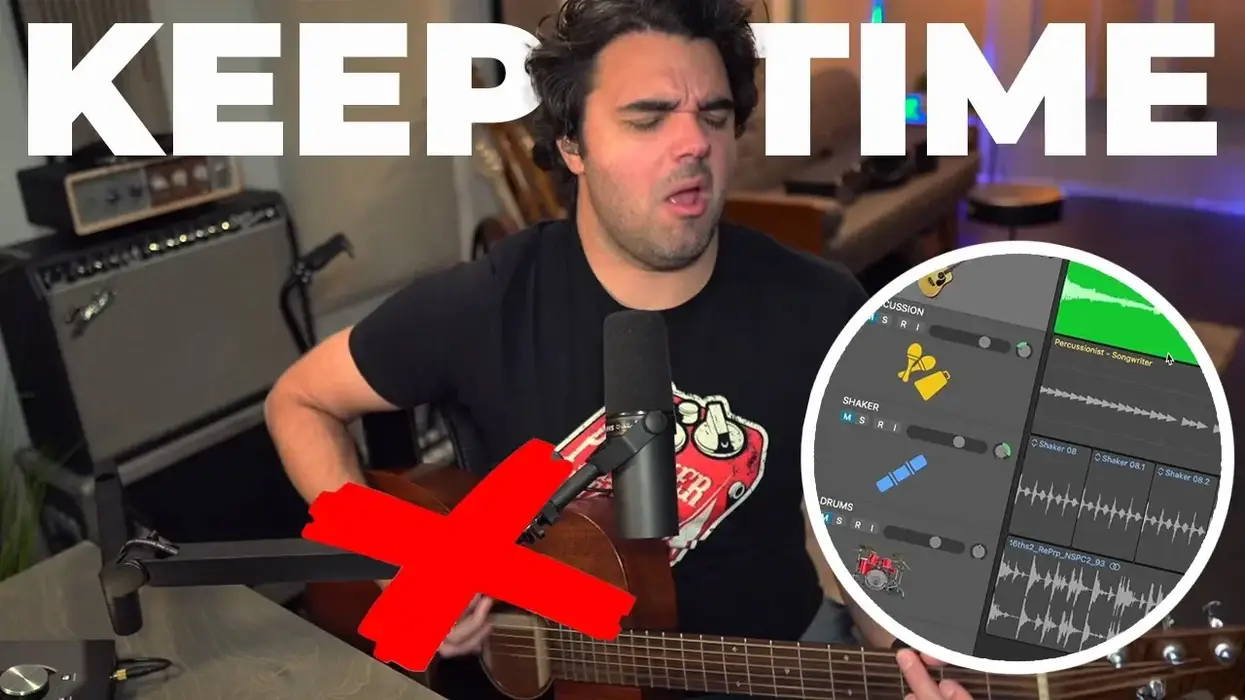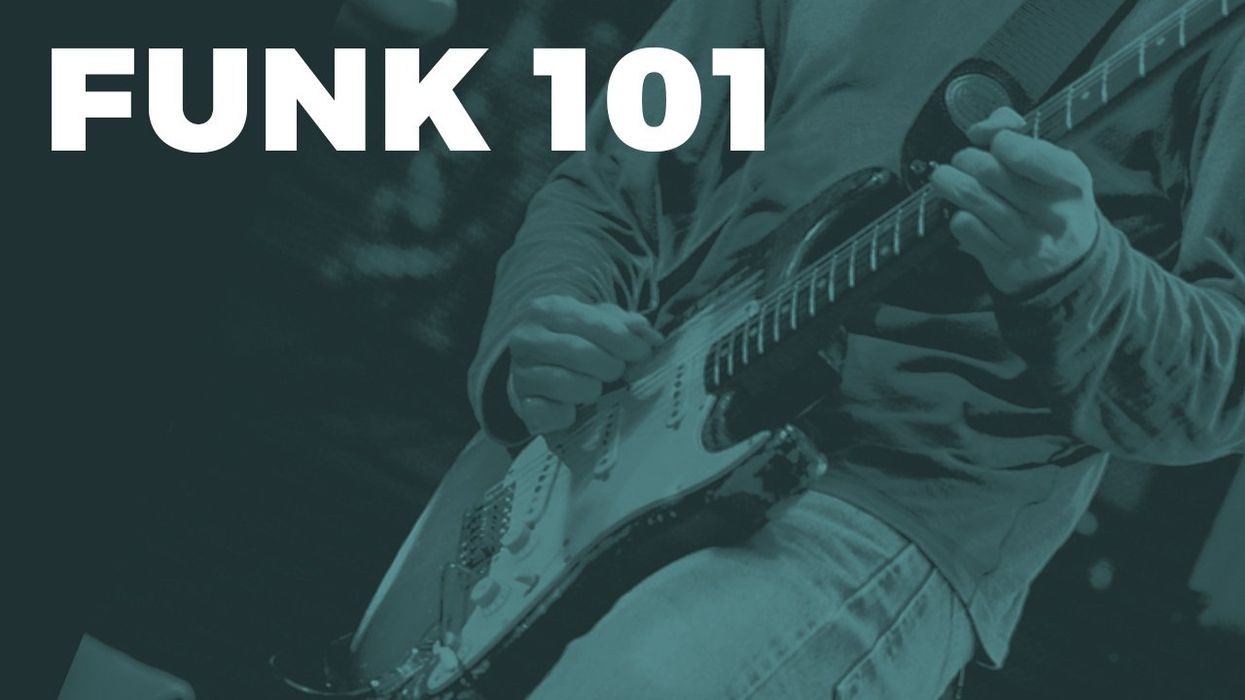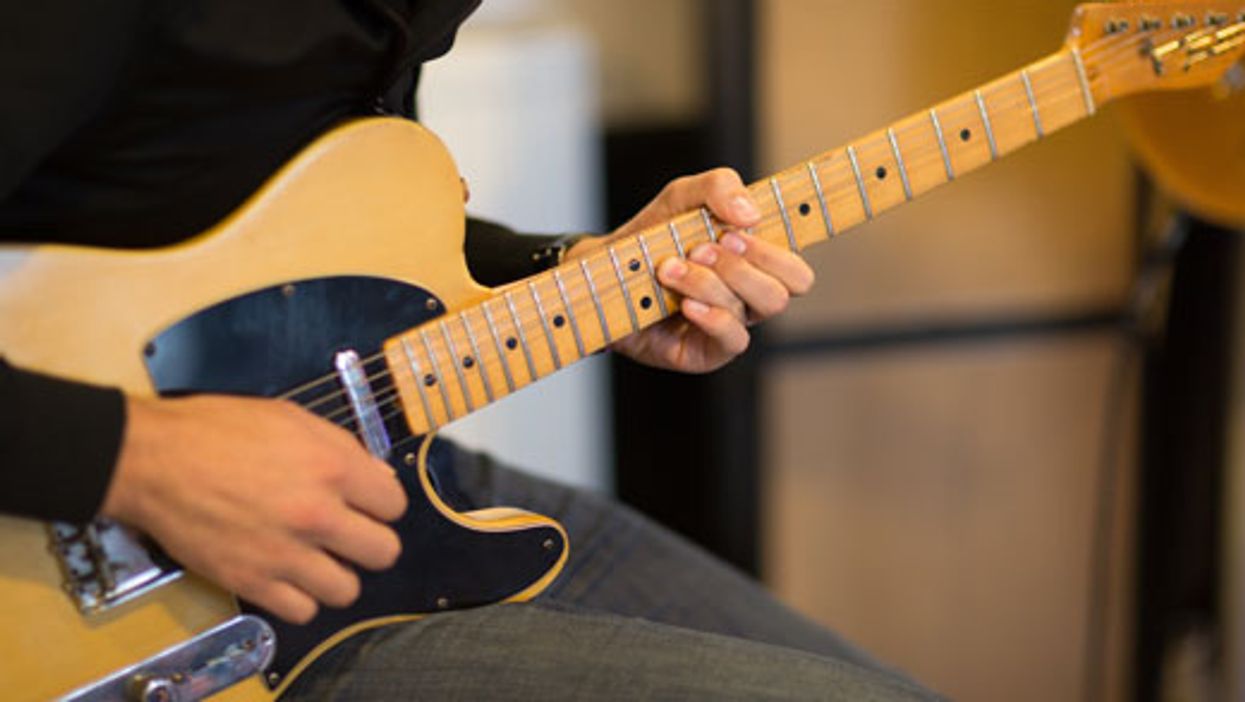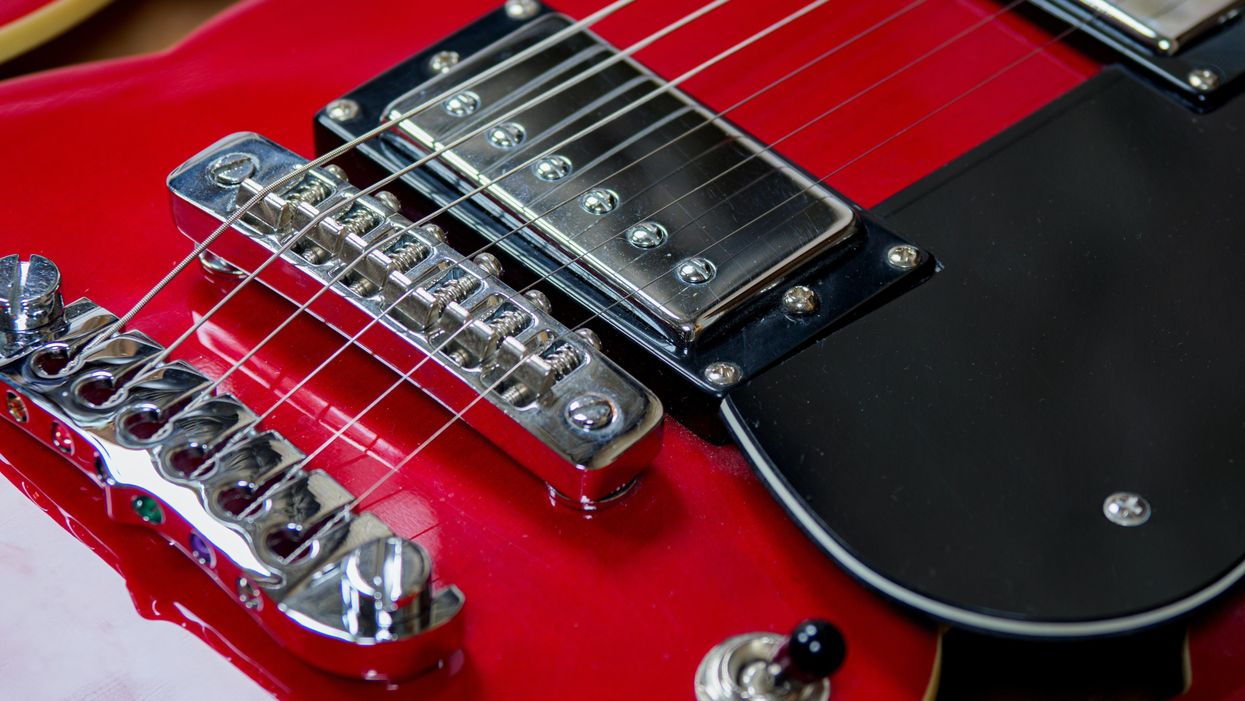Last updated on May 12, 2022
Rhythm guitar is arguably the most important aspect of guitar playing, and it’s also one of the most challenging skills to develop. The discouragement many players feel when working on rhythms forces too many of them to oversimplify the nuances, and this can reduce a performance from exceptional to fine. In this lesson, we’ll investigate why rhythm guitar can be so puzzling and look at a few ways to keep yourself motivated enough to persevere and improve.
Why So Hard?
In my many years of teaching I have found that students can learn the basic open-position chord shapes relatively quickly. The same goes for the pentatonic and major scale patterns. Even riffs and hooks like “Smoke on the Water,” “Crazy Train,” and “Oh, Pretty Woman” come relatively quickly to beginners. The biggest challenge for most guitar players is mastering rhythm guitar.
I’m not referring to the basics, such as four down strums in a measure of 4/4, a down and up eighth-note strum, or even the slightly syncopated strum of Ex. 1.
Ex. 1
Rather, I’m talking about the rhythms in countless classic rock, folk, and pop songs, which are the mainstays—for better or worse—of every oldies station, cover band’s setlist, and many aspiring beginners’ guitar dreams. Why are these rhythms so challenging for most players?
Dictionary.com defines idiosyncratic as “something peculiar to an individual.” Well, there’s your answer. Many of our favorite songs and guitarists, such as Neil Young, Malcolm and Angus Young, Joni Mitchell, David Gilmour, Jimi Hendrix, and Prince, possess idiosyncratic strums. How can something peculiar to an individual be easily reproduced? It can’t. Imitation takes hard work, hours of practice and refinement, and highly developed listening skills. That is not to say that idiosyncratic strums can’t be reproduced, only that they can’t be imitated easily.
What Can Guitar Players do to Improve Their Rhythm?
The first priority is to confirm that you genuinely know how the rhythm was originally performed. In this day and age, with reliable, professionally created guitar transcriptions and instructional videos (as well as an abundance of isolated rhythm guitar tracks on YouTube), there is ample opportunity to both hear and see accurate rhythms. This doesn’t make the rhythm immediately easier to play. It will help you avoid practicing it incorrectly and allow you to generate modifications based on the original, rather than through guesswork.
Play the Part Correctly and Slowly
The second step I recommend is to endeavor to play the part correctly and slowly. This requires playing the rhythms with slower tempos and one measure at a time rather than the more common four-measure patterns. This second aspect is important as many idiosyncratic strums vary from measure to measure. Such a lack of uniformity adds to the artistry of the music, but it can be frustrating to imitate.
For instance, look at Ex. 2, which is similar to Pink Floyd’s “Wish You Were Here.” While the chords themselves, G–C–D–Am, are easy enough to fret, the strum pattern is a nightmare of mixed rhythms, with each measure not only containing a different pattern, but different string choices as well. (To make it even more tricky, David Gilmour continues to vary his rhythms throughout the song.) Let’s consider just the first measure. There’s only one chord, but three different rhythmic figures. It gets even worse than that. Sometimes the strum includes all six strings, other times one note, two notes, or three notes. Maddening! This is one of the most challenging aspects of idiosyncratic rhythm. And these types of variations show up over and over again in accurate portfolio transcriptions. Yes, it is correct, but it’s an ordeal to decipher.
Ex. 2
Here’s a tip. First work on the strum, not the individually plucked notes and strings. Strum the entire G chord (Ex. 3). Next, isolate the lowest note in the chord (Ex. 4). If you can play this correctly then you can begin mixing it up with a combination of full chords, single bass notes, and partial chords. Trust me, Gilmour wasn’t thinking, “Gotta play just the top three strings on the 16th-note upbeat of beat two and the two bottom strings on the ‘and’ of beat four.” It’s idiosyncratic! Once you have measure one correct, move on to measure two, which is slightly different. Measures three and four are also marginally altered.
Ex. 3
Ex. 4
Hopefully you’ll find that one new rhythmic pattern on its own is relatively manageable. Having to generate four different patterns in the space of four measures? In that situation, strums become exponentially more complex. As this lesson moves forward, all the examples will be variations on this theme, in different contexts, and citing different specific artists. The idea here is to demonstrate the vast complexity idiosyncratic playing can generate.
Neil Young's Strumming Patterns
In my experience, Neil Young has some of the most seemingly random strums one can find. He’ll play a song with only four chords but there will be 16 different strum patterns. It’s both inspiring and infuriating. Ex. 5 is an example of such an exasperating figure, based on “Heart of Gold.” There are four chords in two measures, each with a different strum, followed by variations on the same four chords! Brilliant and unbearable.
Ex. 5
Ex. 5
To make mastering this a bit more tolerable, as with the previous Gilmour-esque pattern, break it down into smaller parts. You’ll also want to add full chord strums on the Em and C. Ex. 6. and Ex. 7 demonstrate measures three and four of Ex. 5, isolated and repeated. Do this for the first two measures as well.
Ex. 6
Ex. 6
Ex. 7
Joni Mitchell's "Big Yellow Taxi"
Another icon of individuality is Joni Mitchell, who deserves a lesson all to herself. For now, Ex. 8 will suffice. In this example, based on “Big Yellow Taxi” (although the original is performed in open-E tuning), there is the added complication of muted strums.
Ex. 8
If these muted strums are new to you, I recommend you focus on the mutes, as shown in Ex. 9. Once that is comfortable, return to Ex. 8 and incorporate the barre chords into the pattern. As with all our examples thus far, break them down, making sure each measure is solid before moving on to the next. At the risk of belaboring the point, these strums are demanding—there is no instant gratification here. “Practice and refine” should be your mantra.
Ex. 9
Let's Talk About Jimi Hendrix
It would be impossible to write about either guitar icons or 6-string idiosyncrasy without mentioning Jimi Hendrix. Jimi’s use of his thumb to fret chords is alone worthy of attention. For now, let’s stick with his eccentric strumming patterns. A good place to start is probably Hendrix’s version of “Hey Joe.” It consists of a three-and-a-half-minute loop of the circle of fourths chord progression C–G–D–A–E, yet Jimi finds a new way to play the pattern every time. Ex. 10 offers one of countless variations you can attempt. Ex. 11 demonstrates how to break it down.
Ex. 10
Ex. 11
While it’s true that most AC/DC songs feature the same riff or chord pattern played repetitively, you’ll also find that many of those patterns are four measures long, with multiple, highly syncopated rhythms found within each measure. “You Shook Me All Night Long,” “Bad Boy Boogie,” and “Highway to Hell” are all excellent examples of this. Ex. 12 demonstrates Malcolm and Angus Young’s penchants for such patterns by imitating the rhythms of “For Those About to Rock (We Salute You).” As you can hear, there are four measures with an immense amount of space in them and four different rhythmic figures. The key to perfecting this sort of rhythm is to not rush. Either tap your foot or use a metronome to keep your tempo steady.
Ex. 12
Our final example isn’t exactly idiosyncratic, though the referenced artist is. While Prince’s music and personal style is incredibly diverse, he often wears his influences on his sleeves, whether those be James Brown, Jimi Hendrix, or Joni Mitchell. Nevertheless, he habitually put his own spin on the source inspiration.
Ex. 13 provides you with a funky rhythm that will improve your playing, no matter what genre you specialize in, as it features muted strings (similar to those in our Joni Mitchell example), a fast syncopated 16th-note strum, and a four-measure pattern that requires you to focus on the subtle variations found in the pattern. Once again, I’ll remind you to practice such patterns one measure at a time. Goodness, any one of these measures is funky enough on its own and would satisfy most funk musicians: It’s the idiosyncratic nature of Prince to go beyond.
Ex. 13
Ex. 14 is measure three of Ex. 13 isolated and repeated. I’ve chosen this measure because for me it’s the easiest to play (always start with what’s easiest for you). Note that in Ex. 14, I removed the muted strums. We know they’re in the original and we can add them in soon enough, as demonstrated in Ex. 15.
Ex. 14
Ex. 15
Finally, let’s play all four measures without the mutes, as demonstrated in Ex. 16. It is this sort of compartmentalized, methodical, attention-to-detail practice that will improve your playing.
Ex. 16
Words of Encouragement
Ironically, one of the best things I can tell you about practicing the guitar is, “Learning to play guitar is hard!” I don’t say this to discourage, but to give perspective. If it’s taking you a week to learn a certain rhythmic pattern, guess what? It might take you a month to really get it down. Still, the rewards are worth the effort. Good luck with your rhythms!






















